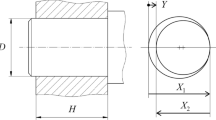Abstract
The goal of this article is to develop a tolerance representation for assemblies compatible with tolerance analysis based on a closed-form algorithm used in robotic applications. A methodology is described that represents standard Y14.5M-1982 tolerances using homogeneous 4×4 matrix transforms. Transforms represent both the nominal relations between parts and the variations caused by geometric deviations allowed by the tolerances. The analysis calculates a statistical estimate of the location of theNth part in an assembly starting from the first part or a fixture. Except forform tolerances, most types of tolerance specifications are compatible with the proposed representation. This approach is well suited to integration with CAD systems and feature-based design. Since assembly apparatus errors can be calculated using the same methodology, one can predict the relative position and angle errors between two parts about to be mated. This permits useful evaluation of assembly equipment errors, comparison of different product tolerance assignments, and calculations of assembly process capability.
Similar content being viewed by others
References
American National Standards Institute,Dimensioning and Tolerancing ANSI Y14.5M-1982, New York: American Society of Mechanical Engineers, 1983.
Baldwin, D. F., Abell, T. E., De Fazio, T. L., Lui, M. C. and Whitney, D. E. “An Integrated Aid for Generating and Evaluating Assembly Sequences for Mechanical Products,”IEEE J. Robotics and Automation, vol. 7, no. 1, Feb. 1991, pp. 78–94.
Bernstein, N. X. “Representation and Analysis of Dimension and Tolerance Information in Solid Modeling,” Ben-Gurion University of the Negev, Department of Mechanical Engineering, M.Sc. thesis, Beer Shava, Israel, 1989.
Bjorke, O.Computer-Aided Tolerancing, second edition, New York: ASME Press, 1989.
Bryson, A. E. and Ho, Y.-C.Applied Optimal Control, New York: John Wiley and Sons, 1975.
De Fazio, T. L., Edsall, A. C., Gustavson, R. E., Hernandez, J. A., Hutchins, P. M., Leung, H.-W., Luby, S. C., Metzinger, R. W., Nevins, J. L., Tung, K. K. and Whitney, D. E. “A Prototype for Feature-Based Design for Assembly,” 1990 ASME Design Automation Conference, vol. DE 23-1, pp. 9–16, Chicago, September 1990.
Gilbert, O. L. “Representation of Geometric Variations Using Matrix Transforms for Statistical Tolerance Analysis in Assemblies”, S.M. thesis, Massachusetts Institute of Technology, Department of Mechanical Engineering, Cambridge, June 1992.
Gossard, D. C. “Bridging the Gap Between Design and Manufacturing — The Role of Tolerances and Features,” Proceedings ofSeagrant Conference, Cambridge, MA, October 1988.
Gossard, D. C., Zuffante, R. P. and Sakurai, H. “Representing Dimensions, Tolerances and Features in MCAE Systems,”IEEE Computer Graphics and Applications, pp. 51–59, March 1988.
Guilford, J. and Turner, J. “Advanced Tolerance Analysis and Synthesis for Geometric Tolerances,”ASME Manufacturing Review, December, 1993.
Hillyard, R. C. and Braid, I. C. “Analysis of Dimensions and Tolerances in Computer-Aided Design,”Computer-Aided Design, vol. 10, no. 3, pp. 209–214, 1978.
Jastrzebski, M. J. “Software for Analysis of 3-D Statistical Tolerances Propagation in Assemblies Using Closed-Form Matrix Transforms,” S.M. thesis, Massachusetts Institute of Technology, Department of Mechanical Engineering, Cambridge, 1991.
Lee, K. and Gossard, D. C. “A Hierarchical Data Structure for Representing Assemblies: Part 1,”Computer-Aided Design, vol. 17, no. 1, pp. 15–19, January 1985.
Light, R. and Gossard, D. “Modification of Geometric Models Through Variational Geometry,”Computer-Aided Design, vol. 14, no. 4, pp. 209–213, July 1982.
Luby, S. C., Dixon, J. R. and Simmons, M. K. “Creating and Using a Feature Data Base,”ASME Conf. on Computers in Mechanical Engineering, Chicago, 1986.
Martino, P. M. and Gabriele, G. A. “Application of Variational Geometry to the Analysis of Mechanical Tolerances,”Proceedings, ASME Advances in Design Automation Conference, vol. 1, Montreal, September 1989.
Nevins, J. L. and Whitney, D. E.Concurrent Design of Products and Processes, New York: McGraw-Hill, 1989.
Requicha, A. G. “Toward a Theory of Geometric Tolerancing,”International Journal of Robotics Research, vol. 2, no. 4, pp. 45–60, winter 1983.
Scott, R. T. “Manufacturing Process Based Computer-Aided Tolerance Analysis for Parts and Assemblies,” Master's thesis, Rensselaer Polytechnic Institute, Department of Mechanical Engineering, Troy, N.Y., 1988.
Scott, R. T. and Gabriele, G. A. “Computer-Aided Tolerance Analysis of Parts and Assemblies,”Proceedings, Advances in Design Automation Conference, vol. 1, pp. 29–36, Montreal, Canada, September 1989.
Shah, J. J. “Assessment of Features Technology,”Journal of CAD, 1990.
Shah, J. J. and Miller, D. “A Structure for Supporting Geometric Tolerances in Product Definition Systems for CIM,”Manufacturing Review, vol. 3, no. 1, pp. 23–31, March 1990.
Sturges, R. H. and Laowattana, S. “A Model of Virtual and Redundant Wedging in Three Dimensions,”Proceedings, ASME 4th Flexible Assembly Systems Conference, September 1992, Phoenix, Ariz.
Turner, J. U. “Relative Positioning of Parts in Assemblies using Mathematical Programming,”Computer-Aided Design, vol. 22, no. 7, pp. 394–400, September 1990.
Turner, J. U. Gangoiti, A. B., “Tolerance Analysis Approaches in Commercial Software,”Concurrent Engineering Issues, Technology, and Practice, vol. 1, no. 2, pp. 11–23, March 1991.
Turner, J. U. and Wozny, M. J. “The M-Space Theory of Tolerances,”Proceedings, Advances in Design Automation Conference, vol. 1, pp. 217–225, Chicago, IL, September 1990.
Veitschegger, W. K. and Wu, Chi-Haur, “Robot Accuracy Analysis Based on Kinematics,”IEEE Journal of Robotics and Automation, vol. RA-2, no. 3, pp. 171–179, September 1986.
Wang, N. and Ozsoy, T. M. “Automatic Generation of Tolerance Chains from Mating Relations Represented in Assembly Models,”Proceedings, Advances in Design Automation Conference, vol. 1, pp. 227–233, Chicago, IL, September 1990.
Wirtz, A. Unpublished talk at ASME Tolerancing Workshop, Orlando, FL, September, 1988.
Author information
Authors and Affiliations
Rights and permissions
About this article
Cite this article
Whitney, D.E., Gilbert, O.L. & Jastrzebski, M. Representation of geometric variations using matrix transforms for statistical tolerance analysis in assemblies. Research in Engineering Design 6, 191–210 (1994). https://doi.org/10.1007/BF01608399
Issue Date:
DOI: https://doi.org/10.1007/BF01608399




